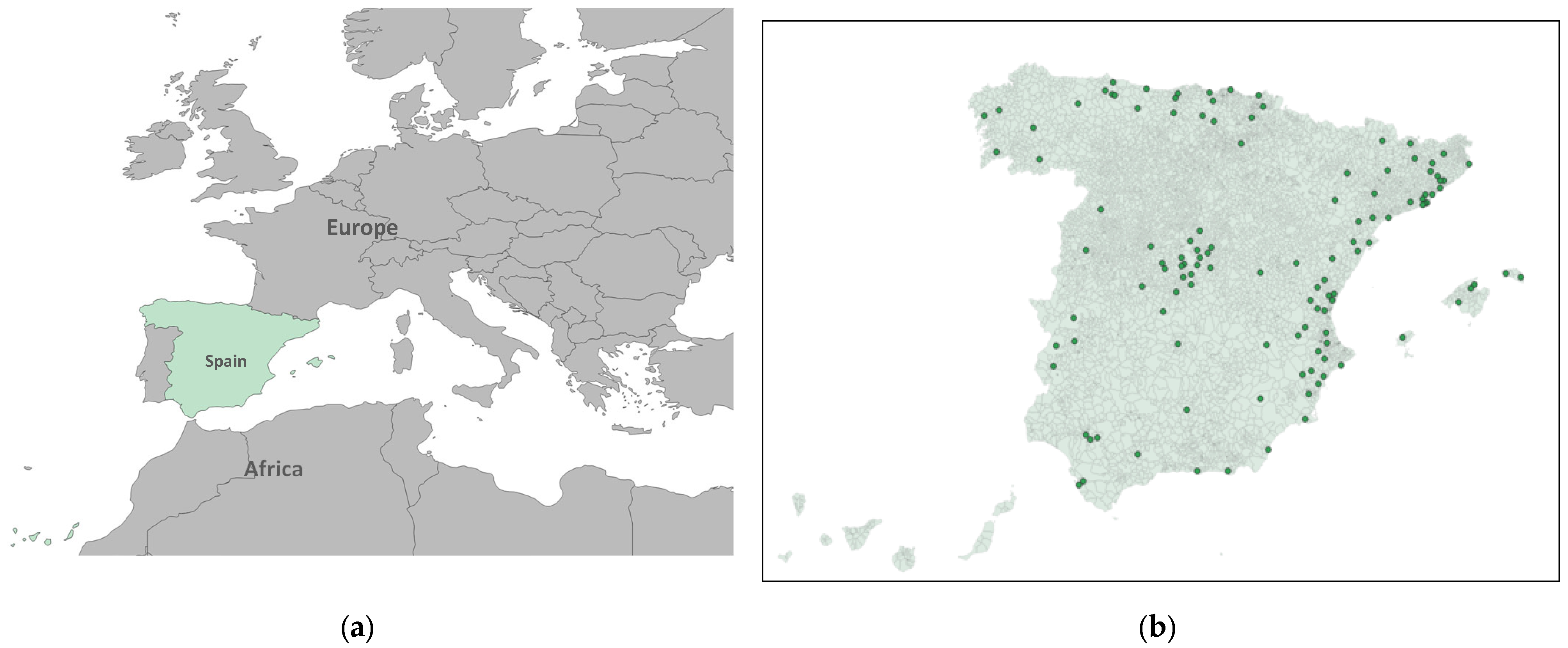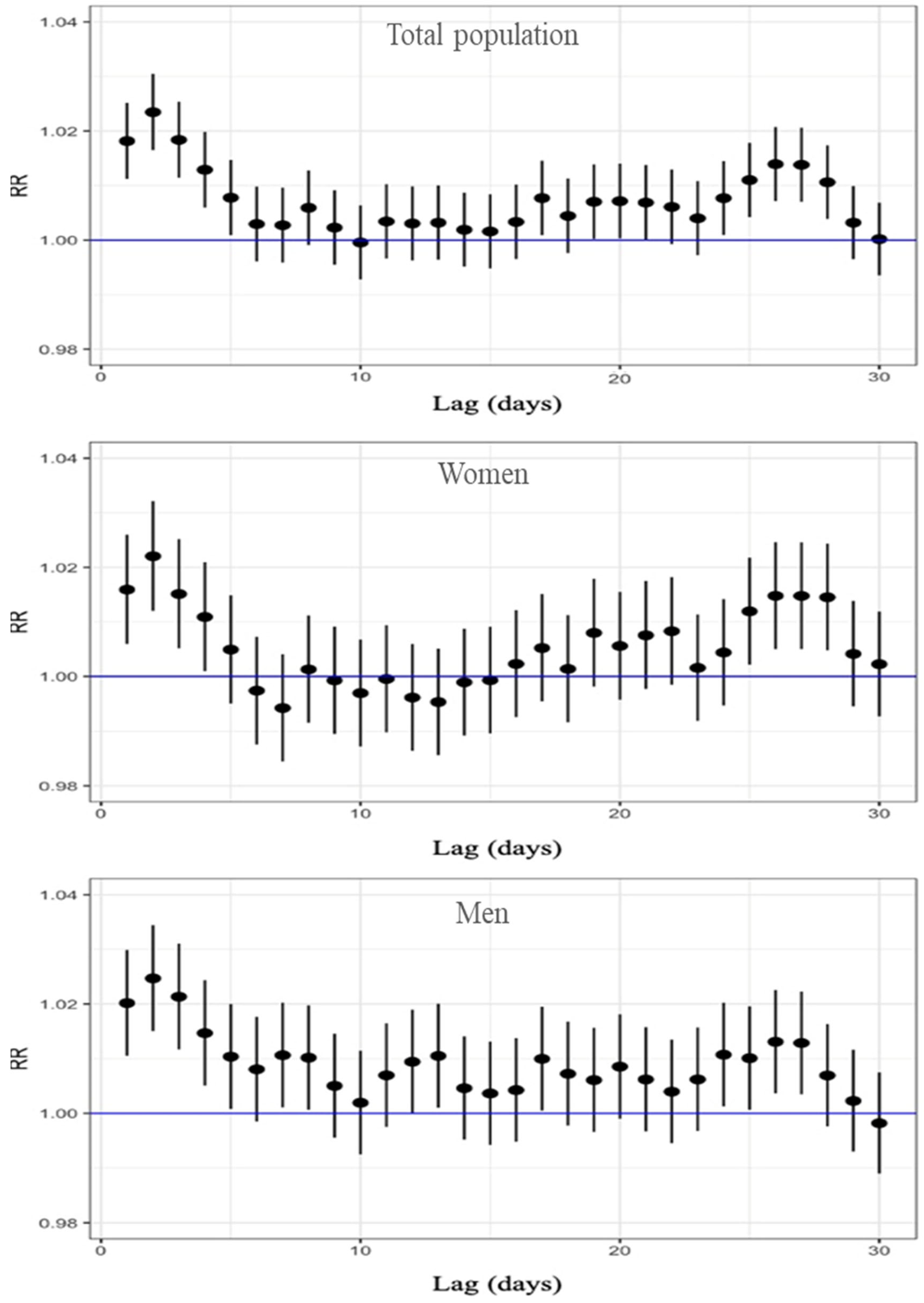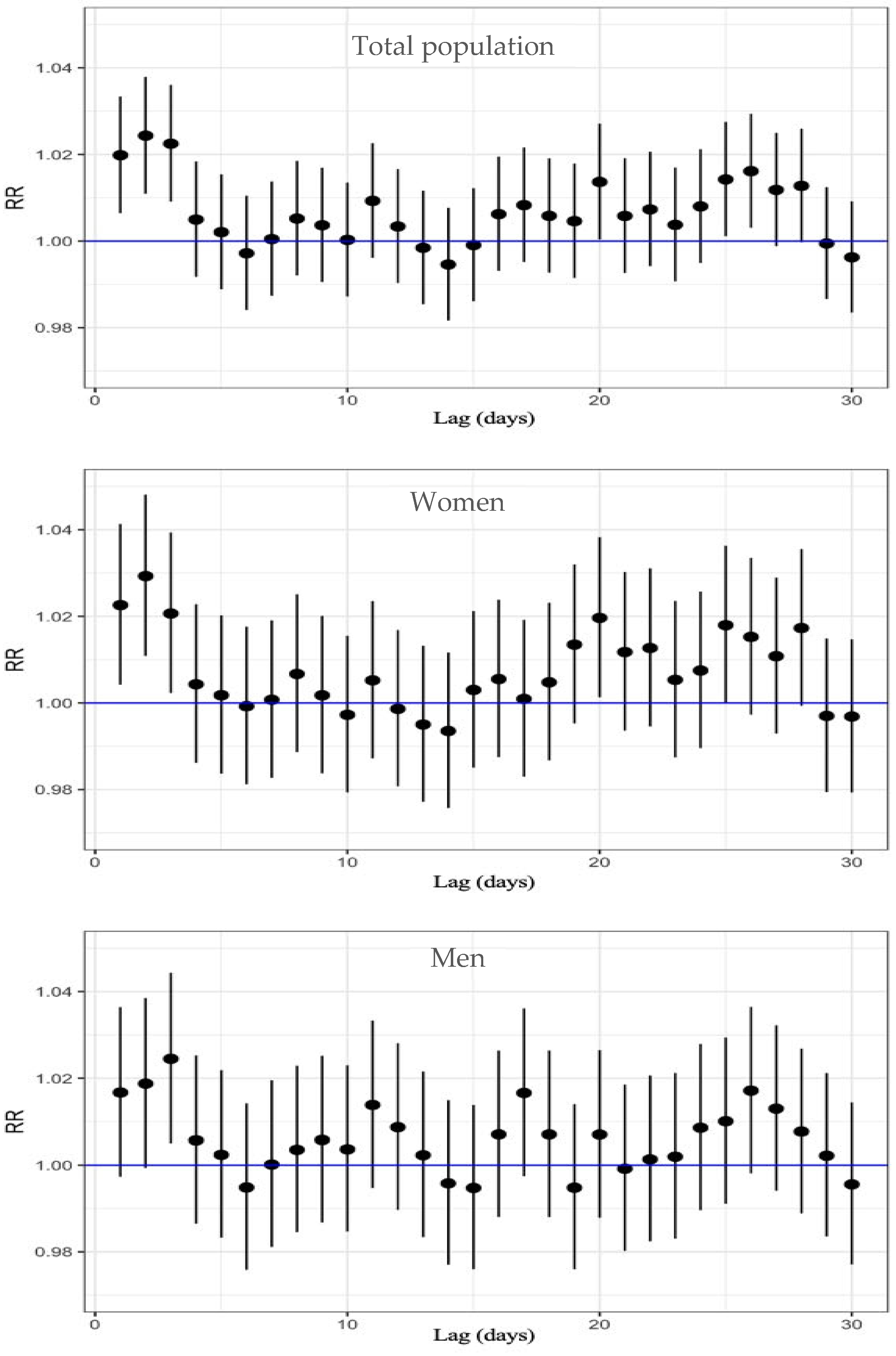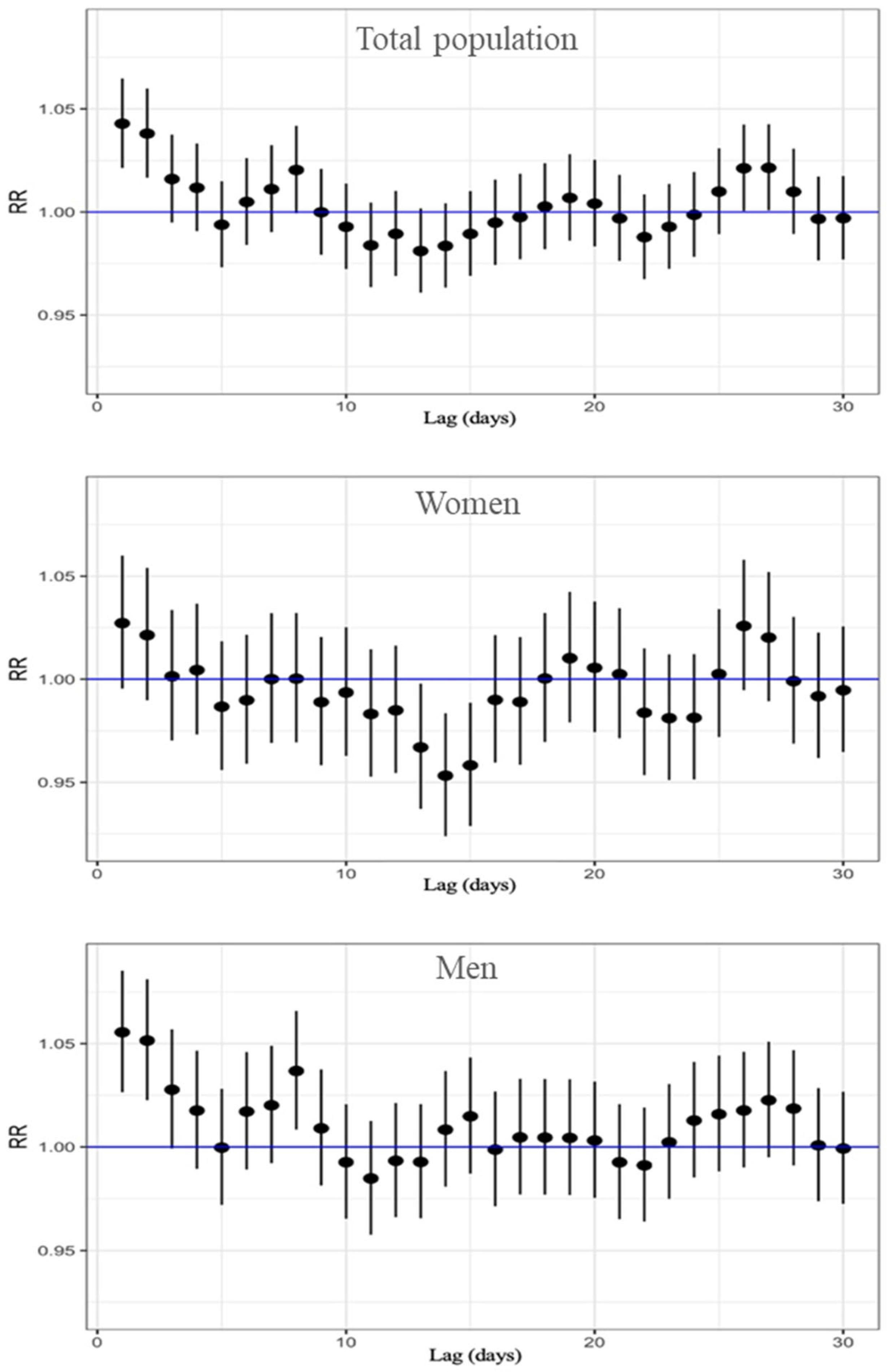Short-Term Ozone Exposure and Daily Mortality in Suburban and Rural Areas of Southern Europe
Abstract
1. Introduction
2. Materials and Methods
2.1. Study Design
2.2. Ozone Concentration Measures
2.3. Control Variables
2.4. Statistical Analysis
3. Results
4. Discussion
5. Conclusions
Supplementary Materials
Author Contributions
Funding
Institutional Review Board Statement
Informed Consent Statement
Data Availability Statement
Conflicts of Interest
Abbreviations
| INE | National Statistics Institute [Instituto Nacional de Estadística] |
| ICD | International Classification of Diseases |
| AEMET | Spanish Meteorological Agency [Agencia Estatatal de Meteorología] |
References
- Moeini, O.; Tarasick, D.W.; McElroy, C.T.; Liu, J.; Osman, M.K.; Thompson, A.M.; Parrington, M.; Palmer, P.I.; Johnson, B.; Oltmans, S.J.; et al. Estimating Wildfire-Generated Ozone over North America Using Ozonesonde Profiles and a Differential Back Trajectory Technique. Atmos. Environ. X 2020, 7, 100078. [Google Scholar] [CrossRef]
- Zhang, J.; Wei, Y.; Fang, Z. Ozone Pollution: A Major Health Hazard Worldwide. Front. Immunol. 2019, 10, 2518. [Google Scholar] [CrossRef]
- Butler, T.; Lupascu, A.; Nalam, A. Attribution of Ground-Level Ozone to Anthropogenic and Natural Sources of Nitrogen Oxides and Reactive Carbon in a Global Chemical Transport Model. Atmos. Chem. Phys. 2020, 20, 10707–10731. [Google Scholar] [CrossRef]
- Qu, K.; Yan, Y.; Wang, X.; Jin, X.; Vrekoussis, M.; Kanakidou, M.; Brasseur, G.P.; Lin, T.; Xiao, T.; Cai, X.; et al. The Effect of Cross-Regional Transport on Ozone and Particulate Matter Pollution in China: A Review of Methodology and Current Knowledge. Sci. Total Environ. 2024, 947, 174196. [Google Scholar] [CrossRef] [PubMed]
- Holloway, T.; Fiore, A.; Hastings, M.G. Intercontinental Transport of Air Pollution: Will Emerging Science Lead to a New Hemispheric Treaty? Environ. Sci. Technol. 2003, 37, 4535–4542. [Google Scholar] [CrossRef] [PubMed][Green Version]
- García, M.Á.; Villanueva, J.; Pardo, N.; Pérez, I.A.; Sánchez, M.L. Analysis of Ozone Concentrations between 2002–2020 in Urban Air in Northern Spain. Atmosphere 2021, 12, 1495. [Google Scholar] [CrossRef]
- Nguyen, D.-H.; Lin, C.; Vu, C.-T.; Cheruiyot, N.K.; Nguyen, M.K.; Le, T.H.; Lukkhasorn, W.; Vo, T.-D.-H.; Bui, X.-T. Tropospheric Ozone and NOx: A Review of Worldwide Variation and Meteorological Influences. Environ. Technol. Innov. 2022, 28, 102809. [Google Scholar] [CrossRef]
- European Environment Agency. Annex 2. Phenomenology of Ozone Concentrations. Available online: https://www.eea.europa.eu/en/analysis/publications/c1i92-9167-123-1/page008.html (accessed on 31 March 2025).
- Petetin, H.; Thouret, V.; Athier, G.; Blot, R.; Boulanger, D.; Cousin, J.-M.; Gaudel, A.; Nédélec, P.; Cooper, O. Diurnal Cycle of Ozone Throughout the Troposphere over Frankfurt as Measured by MOZAIC-IAGOS Commercial Aircraft. Elem. Sci. Anthr. 2016, 4, 000129. [Google Scholar] [CrossRef]
- Bernier, C.; Wang, Y.; Estes, M.; Lei, R.; Jia, B.; Wang, S.C.; Sun, J. Clustering Surface Ozone Diurnal Cycles to Understand the Impact of Circulation Patterns in Houston, TX. J. Geophys. Res. Atmos. 2019, 124, 13457–13474. [Google Scholar] [CrossRef]
- European Environment Agency. Europe’s Air Quality Status 2023. Available online: https://www.eea.europa.eu/publications/europes-air-quality-status-2023/europes-air-quality-status2023 (accessed on 31 March 2025).
- Zhao, T.; Markevych, I.; Fuertes, E.; de Hoogh, K.; Accordini, S.; Boudier, A.; Casas, L.; Forsberg, B.; Aymerich, J.G.; Gnesi, M.; et al. Impact of Long-Term Exposure to Ambient Ozone on Lung Function over a Course of 20 Years [The ECRHS Study]: A Prospective Cohort Study in Adults. Lancet Reg. Health Eur. 2023, 34, 100729. [Google Scholar] [CrossRef]
- Jerrett, M.; Burnett, R.T.; Pope, C.A., III; Ito, K.; Thurston, G.; Krewski, D.; Shi, Y.; Calle, E.; Thun, M. Long-Term Ozone Exposure and Mortality. N. Engl. J. Med. 2009, 360, 1085–1095. [Google Scholar] [CrossRef] [PubMed]
- Lim, C.C.; Hayes, R.B.; Ahn, J.; Shao, Y.; Silverman, D.T.; Jones, R.R.; García, C.; Bell, M.L.; Thurston, G.D. Long-Term Exposure to Ozone and Cause-Specific Mortality Risk in the United States. Am. J. Respir. Crit. Care Med. 2019, 200, 1022–1031. [Google Scholar] [CrossRef] [PubMed]
- Wang, Y.; Cao, R.; Xu, Z.; Jin, J.; Wang, J.; Yang, T.; Wei, J.; Huang, J.; Li, G. Long-Term Exposure to Ozone and Diabetes Incidence: A Longitudinal Cohort Study in China. Sci. Total Environ. 2022, 816, 151634. [Google Scholar] [CrossRef] [PubMed]
- Zhan, Q.; Meng, X.; Wang, H.; Yu, Y.; Su, X.; Huang, Y.; Yu, L.; Du, Y.; Zhang, F.; An, Q.; et al. Long-Term Low-Level Ozone Exposure and the Incidence of Type 2 Diabetes Mellitus and Glycemic Levels: A Prospective Cohort Study from Southwest China. Ecotoxicol. Environ. Saf. 2025, 293, 118028. [Google Scholar] [CrossRef]
- Yu, S.; Zhang, M.; Zhu, J.; Yang, X.; Bigambo, F.M.; Snijders, A.M.; Wang, X.; Hu, W.; Lv, W.; Xia, Y. The Effect of Ambient Ozone Exposure on Three Types of Diabetes: A Meta-Analysis. Environ. Health 2023, 22, 32. [Google Scholar] [CrossRef]
- Kim, E.; Huh, H.; Mo, Y.; Park, J.Y.; Jung, J.; Lee, H.; Kim, S.; Kim, D.K.; Kim, Y.S.; Lim, C.S.; et al. Long-Term Ozone Exposure and Mortality in Patients with Chronic Kidney Disease: A Large Cohort Study. BMC Nephrol. 2024, 25, 74. [Google Scholar] [CrossRef]
- U.S. Environmental Protection Agency. Health Effects of Ozone in the General Population. Available online: https://www.epa.gov/ozone-pollution-and-your-patients-health/health-effects-ozone-general-population (accessed on 1 April 2025).
- Vicedo-Cabrera, A.M.; Sera, F.; Liu, C.; Armstrong, B.; Milojevic, A.; Guo, Y.; Tong, S.; Lavigne, E.; Kyselý, J.; Urban, A.; et al. Short Term Association between Ozone and Mortality: Global Two Stage Time Series Study in 406 Locations in 20 Countries. BMJ 2020, 368, m108. [Google Scholar] [CrossRef]
- Bell, M.L.; McDermott, A.; Zeger, S.L.; Samet, J.M.; Dominici, F. Ozone and Short-Term Mortality in 95 US Urban Communities, 1987–2000. JAMA 2004, 292, 2372–2378. [Google Scholar] [CrossRef]
- Yin, P.; Chen, R.; Wang, L.; Meng, X.; Liu, C.; Niu, Y.; Lin, Z.; Liu, Y.; Liu, J.; Qi, J.; et al. Ambient Ozone Pollution and Daily Mortality: A Nationwide Study in 272 Chinese Cities. Environ. Health Perspect. 2017, 125, 117006. [Google Scholar] [CrossRef]
- Raza, A.; Dahlquist, M.; Lind, T.; Ljungman, P.L.S. Susceptibility to Short-Term Ozone Exposure and Cardiovascular and Respiratory Mortality by Previous Hospitalizations. Environ. Health 2018, 17, 37. [Google Scholar] [CrossRef]
- Zhang, X.; Yan, B.; Zhou, Y.; Osei, F.; Li, Y.; Zhao, H.; Cheng, C.; Stein, A. Short-term health impacts related to ozone in China before and after implementation of policy measures: A systematic review and meta-analysis. Sci. Total Environ. 2022, 847, 157588. [Google Scholar] [CrossRef]
- Air Pollution Accounted for 8.1 Million Deaths Globally in 2021, Becoming the Second Leading Risk Factor for Death, Including for Children Under 5 Years|Institute for Health Metrics and Evaluation. (n.d.). Available online: https://www.healthdata.org/news-events/newsroom/news-releases/air-pollution-accounted-81-million-deaths-globally-2021-becoming (accessed on 8 May 2025).
- Brauer, M.; Roth, G.A.; Aravkin, A.Y.; Zheng, P.; Abate, K.H.; Abate, Y.H.; Abbafati, C.; Abbasgholizadeh, R.; Abbasi, M.A.; Abbasian, M.; et al. Global burden and strength of evidence for 88 risk factors in 204 countries and 811 subnational locations, 1990–2021: A systematic analysis for the Global Burden of Disease Study 2021. Lancet 2024, 403, 2162–2203. [Google Scholar] [CrossRef]
- Sicard, P.; Agathokleous, E.; Anenberg, S.C.; De Marco, A.; Paoletti, E.; Calatayud, V. Trends in urban air pollution over the last two decades: A global perspective. Sci. Total Environ. 2023, 858, 160064. [Google Scholar] [CrossRef]
- Hu, W.; Yang, J. Effect of ambient ozone pollution on disease burden globally: A systematic analysis for the global burden of disease study 2019. Sci. Total Environ. 2024, 926, 171739. [Google Scholar] [CrossRef]
- Malashock, D.A.; DeLang, M.N.; Becker, J.S.; Serre, M.L.; West, J.J.; Chang, K.-L.; Cooper, O.R.; Anenberg, S.C. Estimates of ozone concentrations and attributable mortality in urban, peri-urban and rural areas worldwide in 2019. Environ. Res. Lett. 2022, 17, 054023. [Google Scholar] [CrossRef]
- Malashock, D.A.; Delang, M.N.; Becker, J.S.; Serre, M.L.; West, J.J.; Chang, K.-L.; Cooper, O.R.; Anenberg, S.C. Global trends in ozone concentration and attributable mortality for urban, peri-urban, and rural areas between 2000 and 2019: A modelling study. Lancet Planet. Health 2022, 6, e958–e967. [Google Scholar] [CrossRef]
- Achebak, H.; Garatachea, R.; Pay, M.T.; Jorba, O.; Guevara, M.; Pérez García-Pando, C.; Ballester, J. Geographic sources of ozone air pollution and mortality burden in Europe. Nat. Med. 2022, 30, 1732–1738. [Google Scholar] [CrossRef]
- Sicard, P.; Agathokleous, E.; De Marco, A.; Paoletti, E.; Calatayud, V. Urban population exposure to air pollution in Europe over the last decades. Environ. Sci. Eur. 2021, 33, 28. [Google Scholar] [CrossRef]
- Ministerio Para la Transición Ecológica y el Reto Demográfico. Gobierno de España. Evaluación de la Calidad del Aire en España (año 2022). 2023. Available online: https://www.miteco.gob.es/content/dam/miteco/es/calidad-y-evaluacion-ambiental/temas/atmosfera-y-calidad-del-aire/informeevaluacioncalidadaireespana2022_tcm30-590211.pdf (accessed on 3 April 2025).
- Salonen, H.; Salthammer, T.; Morawska, L. Human exposure to ozone in school and office indoor environments. Environ. Int. 2018, 119, 503–514. [Google Scholar] [CrossRef]
- Lin, C.; Ma, Y.; Liu, R.; Shao, Y.; Ma, Z.; Zhou, L.; Jing, Y.; Bell, M.L.; Chen, K. Associations between Short-Term Ambient Ozone Exposure and Cause-Specific Mortality in Rural and Urban Areas of Jiangsu, China. Environ. Res. 2022, 211, 113098. [Google Scholar] [CrossRef]
- Nelson, B.; Drysdale, W. Urban Ozone Trends in Europe and the USA (2000–2021). EGUsphere 2025, 2024–3743. [Google Scholar]
- Ballester, F.; Sáez, M.; Daponte, A.; Ordóñez, J.M.; Taracido, M.; Cambra, K.; Arribas, F.; Bellido, J.B.; Guillén, J.J.; Aguinaga, I.; et al. El proyecto EMECAS: Protocolo del estudio multicéntrico en España de los efectos a corto plazo de la contaminación atmosférica sobre la salud. Rev. Esp. Salud Pública 2005, 79, 229–242. [Google Scholar] [CrossRef]
- Díaz, J.; Ortiz, C.; Falcón, I.; Salvador, C.; Linares, C. Short-term effect of tropospheric ozone on daily mortality in Spain. Atmos. Environ. 2018, 187, 107–116. [Google Scholar] [CrossRef]
- Instituto Nacional de Estadística [INE]. Instituto Nacional de Estadística—INE. Available online: https://www.ine.es/ (accessed on 1 April 2025).
- Ley 7/1985, de 2 de Abril, Reguladora de las Bases del Régimen Local. Boletín Oficial del Estado, núm. 80, 3 de abril de 1985, pp. 8945–8964. Available online: https://www.boe.es/buscar/act.php?id=BOE-A-1985-5392 (accessed on 2 April 2025).
- Organización Mundial de la Salud. Clasificación Internacional de Enfermedades [CIE-10]. Available online: https://www.who.int/classifications/icd/en/ (accessed on 2 April 2025).
- Real Decreto 102/2011, de 28 de Enero, Relativo a la Mejora de la Calidad del Aire. Boletín Oficial del Estado, núm. 25, 29 de Enero de 2011, pp. 9574–9613. Available online: https://www.boe.es/buscar/act.php?id=BOE-A-2011-1645 (accessed on 2 April 2025).
- Ministerio para la Transición Ecológica y el Reto Demográfico. Ministerio para la Transición Ecológica y el Reto Demográfico; Gobierno de España: Madrid, España. Available online: https://www.miteco.gob.es/es.html (accessed on 3 April 2025).
- Coates, J.; Mar, K.A.; Ojha, N.; Butler, T.M. The Influence of Temperature on Ozone Production under Varying NOx Conditions—A Modelling Study. Atmos. Chem. Phys. 2016, 16, 11601–11615. [Google Scholar] [CrossRef]
- Zhang, X.; Waugh, D.W.; Kerr, G.H.; Miller, S.M. Surface Ozone-Temperature Relationship: The Meridional Gradient Ratio Approximation. Geophys. Res. Lett. 2022, 49, e2022GL098680. [Google Scholar] [CrossRef]
- Agencia Estatal de Meteorología. Agencia Estatal de Meteorología—AEMET. Gobierno de España. Available online: https://www.aemet.es/es/portada (accessed on 3 April 2025).
- Chiusolo, M.; Cadum, E.; Stafoggia, M.; Galassi, C.; Berti, G.; Faustini, A.; Bisanti, L.; Vigotti, M.A.; Dessì, M.P.; Cernigliaro, A.; et al. Short-Term Effects of Nitrogen Dioxide on Mortality and Susceptibility Factors in 10 Italian Cities: The EpiAir Study. Environ. Health Perspect. 2011, 119, 1233–1238. [Google Scholar] [CrossRef]
- Fu, J.; Fei, F.; Wang, S.; Zhao, Q.; Yang, X.; Zhong, J.; Hu, K. Short-Term Effects of Fine Particulate Matter Constituents on Mortality Considering the Mortality Displacement in Zhejiang Province, China. J. Hazard. Mater. 2023, 457, 131723. [Google Scholar] [CrossRef]
- Stafoggia, M.; Bellander, T. Short-Term Effects of Air Pollutants on Daily Mortality in the Stockholm County—A Spatiotemporal Analysis. Environ. Res. 2020, 188, 109854. [Google Scholar] [CrossRef]
- Chen, K.; Zhou, L.; Chen, X.; Bi, J.; Kinney, P.L. Acute Effect of Ozone Exposure on Daily Mortality in Seven Cities of Jiangsu Province, China: No Clear Evidence for Threshold. Environ. Res. 2017, 155, 235–241. [Google Scholar] [CrossRef] [PubMed]
- Ozone and Daily Mortality Rate in 21 Cities of East Asia: How Does Season Modify the Association? Am. J. Epidemiol. 2014, 180, 729–739. [CrossRef]
- Day, D.B.; Xiang, J.; Mo, J.; Li, F.; Chung, M.; Gong, J.; Weschler, C.J.; Ohman-Strickland, P.A.; Sundell, J.; Weng, W.; et al. Association of Ozone Exposure With Cardiorespiratory Pathophysiologic Mechanisms in Healthy Adults. JAMA Intern. Med. 2017, 177, 1344–1353. [Google Scholar] [CrossRef]
- Mirowsky, J.E.; Carraway, M.S.; Dhingra, R.; Tong, H.; Neas, L.; Diaz-Sanchez, D.; Cascio, W.; Case, M.; Crooks, J.; Hauser, E.R.; et al. Ozone Exposure Is Associated with Acute Changes in Inflammation, Fibrinolysis, and Endothelial Cell Function in Coronary Artery Disease Patients. Environ. Health 2017, 16, 126. [Google Scholar] [CrossRef] [PubMed]
- Guo, X.; Su, W.; Wang, H.; Li, N.; Song, Q.; Liang, Q.; Sun, C.; Liang, M.; Zhou, Z.; Song, E.J.; et al. Short-Term Exposure to Ambient Ozone and Cardiovascular Mortality in China: A Systematic Review and Meta-Analysis. Int. J. Environ. Health Res. 2023, 33, 958–975. [Google Scholar] [CrossRef]
- Chen, C.; Li, T.; Sun, Q.; Shi, W.; He, M.Z.; Wang, J.; Liu, J.; Zhang, M.; Jiang, Q.; Wang, M.; et al. Short-Term Exposure to Ozone and Cause-Specific Mortality Risks and Thresholds in China: Evidence from Nationally Representative Data, 2013–2018. Environ. Int. 2023, 171, 107666. [Google Scholar] [CrossRef]
- Wu, H.; Lu, K.; Fu, J. A Time-Series Study for Effects of Ozone on Respiratory Mortality and Cardiovascular Mortality in Nanchang, Jiangxi Province, China. Front. Public Health 2022, 10, 864537. [Google Scholar] [CrossRef]
- Cortes, T.R.; Silveira, I.H.; de Oliveira, B.F.A.; Bell, M.L.; Junger, W.L. Short-Term Association Between Ambient Air Pollution and Cardio-Respiratory Mortality in Rio de Janeiro, Brazil. PLoS ONE 2023, 18, e0281499. [Google Scholar] [CrossRef]
- Wang, T.; Wang, J.; Sun, L.; Deng, Y.; Xiang, Y.; Wang, Y.; Chen, J.; Peng, W.; Cui, Y.; He, M. Effect of Ozone Exposure on Cardiovascular and Cerebrovascular Disease Mortality in the Elderly. Toxics 2025, 13, 184. [Google Scholar] [CrossRef]
- Devlin, R.B.; McDonnell, W.F.; Mann, R.; Becker, S.; House, D.E.; Schreinemachers, D.; Koren, H.S. Exposure of Humans to Ambient Levels of Ozone for 6.6 Hours Causes Cellular and Biochemical Changes in the Lung. Am. J. Respir. Cell Mol. Biol. 1991, 4, 72–81. [Google Scholar] [CrossRef]
- Zhang, Y.; West, J.J.; Emmons, L.K.; Flemming, J.; Jonson, J.E.; Lund, M.T.; Sekiya, T.; Sudo, K.; Gaudel, A.; Chang, K.L.; et al. Contributions of World Regions to the Global Tropospheric Ozone Burden Change From 1980 to 2010. Geophys. Res. Lett. 2021, 48, e2020GL089184. [Google Scholar] [CrossRef]
- Centers for Disease Control and Prevention [CDC]. About Tobacco Use and Prevention. Available online: https://www.cdc.gov/tobacco/about/index.html (accessed on 6 April 2025).




| Total n (%) | Women n (%) | Men n (%) | |
|---|---|---|---|
| All cause mortality | 33,397 | 16,091 (48.2%) | 17,306 (51.8%) |
| Cardiovascular mortality | 8992 | 4749 (52.8%) | 4243 (47.2%) |
| Respiratory mortality | 3604 | 1586 (44.0%) | 2018 (56.0%) |
| Ozone (µg/m3) * | 95.09 (20.26) | - | - |
| Maximum temperature (°C) * | 28.48 (6.53) | - | - |
Disclaimer/Publisher’s Note: The statements, opinions and data contained in all publications are solely those of the individual author(s) and contributor(s) and not of MDPI and/or the editor(s). MDPI and/or the editor(s) disclaim responsibility for any injury to people or property resulting from any ideas, methods, instructions or products referred to in the content. |
© 2025 by the authors. Licensee MDPI, Basel, Switzerland. This article is an open access article distributed under the terms and conditions of the Creative Commons Attribution (CC BY) license (https://creativecommons.org/licenses/by/4.0/).
Share and Cite
Doronzo, M.A.; Martinez Fernandez, J.R.; Gómez-Barroso, D.; Alonso-Colón, M.; Nuñez-Corcuera, B.; Ramis, R. Short-Term Ozone Exposure and Daily Mortality in Suburban and Rural Areas of Southern Europe. Atmosphere 2025, 16, 625. https://doi.org/10.3390/atmos16050625
Doronzo MA, Martinez Fernandez JR, Gómez-Barroso D, Alonso-Colón M, Nuñez-Corcuera B, Ramis R. Short-Term Ozone Exposure and Daily Mortality in Suburban and Rural Areas of Southern Europe. Atmosphere. 2025; 16(5):625. https://doi.org/10.3390/atmos16050625
Chicago/Turabian StyleDoronzo, Maria Angela, José Ramón Martinez Fernandez, Diana Gómez-Barroso, María Alonso-Colón, Beatriz Nuñez-Corcuera, and Rebeca Ramis. 2025. "Short-Term Ozone Exposure and Daily Mortality in Suburban and Rural Areas of Southern Europe" Atmosphere 16, no. 5: 625. https://doi.org/10.3390/atmos16050625
APA StyleDoronzo, M. A., Martinez Fernandez, J. R., Gómez-Barroso, D., Alonso-Colón, M., Nuñez-Corcuera, B., & Ramis, R. (2025). Short-Term Ozone Exposure and Daily Mortality in Suburban and Rural Areas of Southern Europe. Atmosphere, 16(5), 625. https://doi.org/10.3390/atmos16050625







